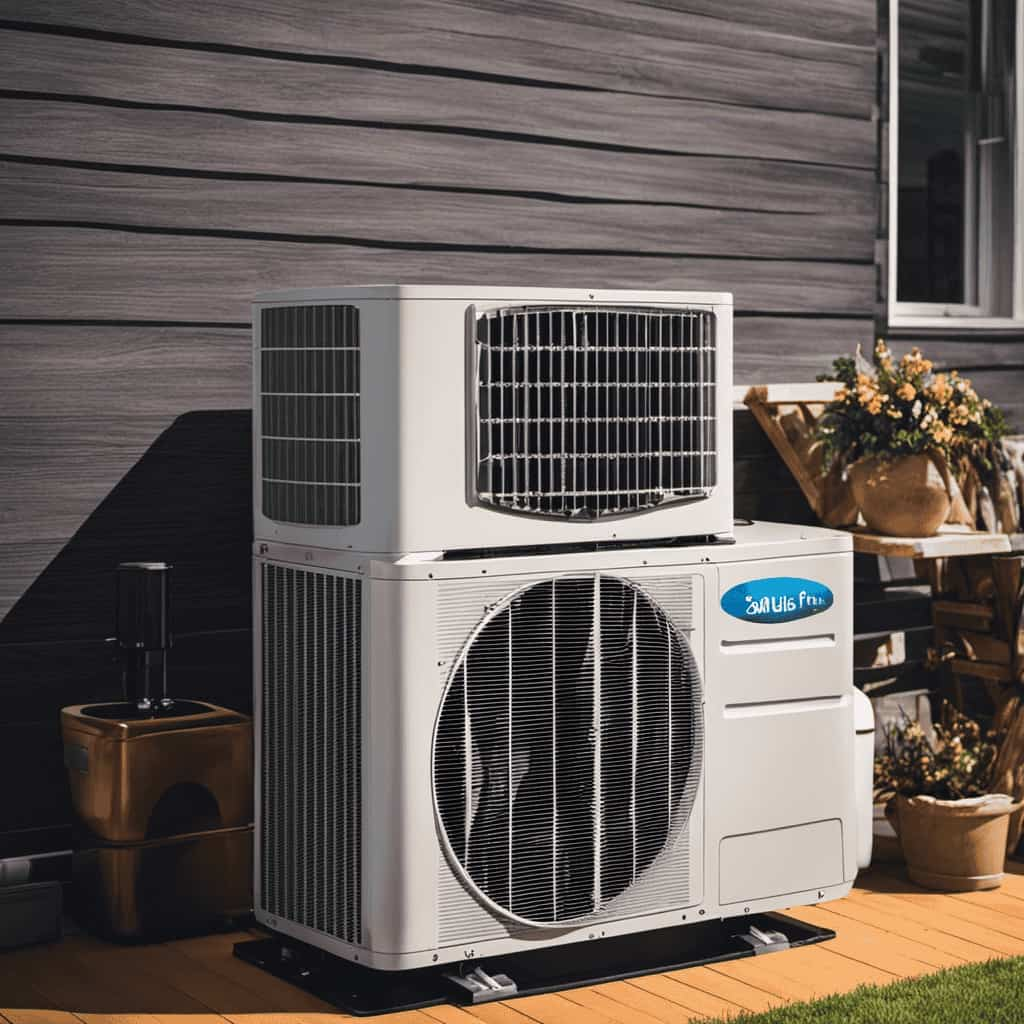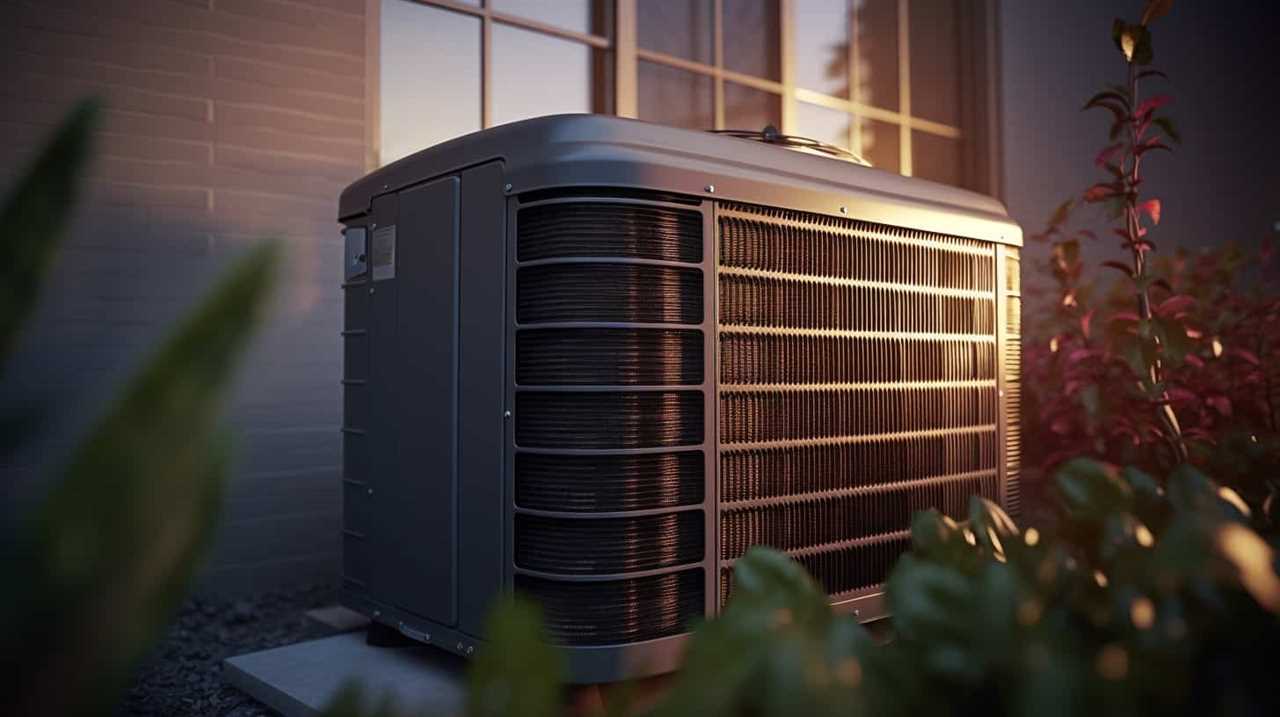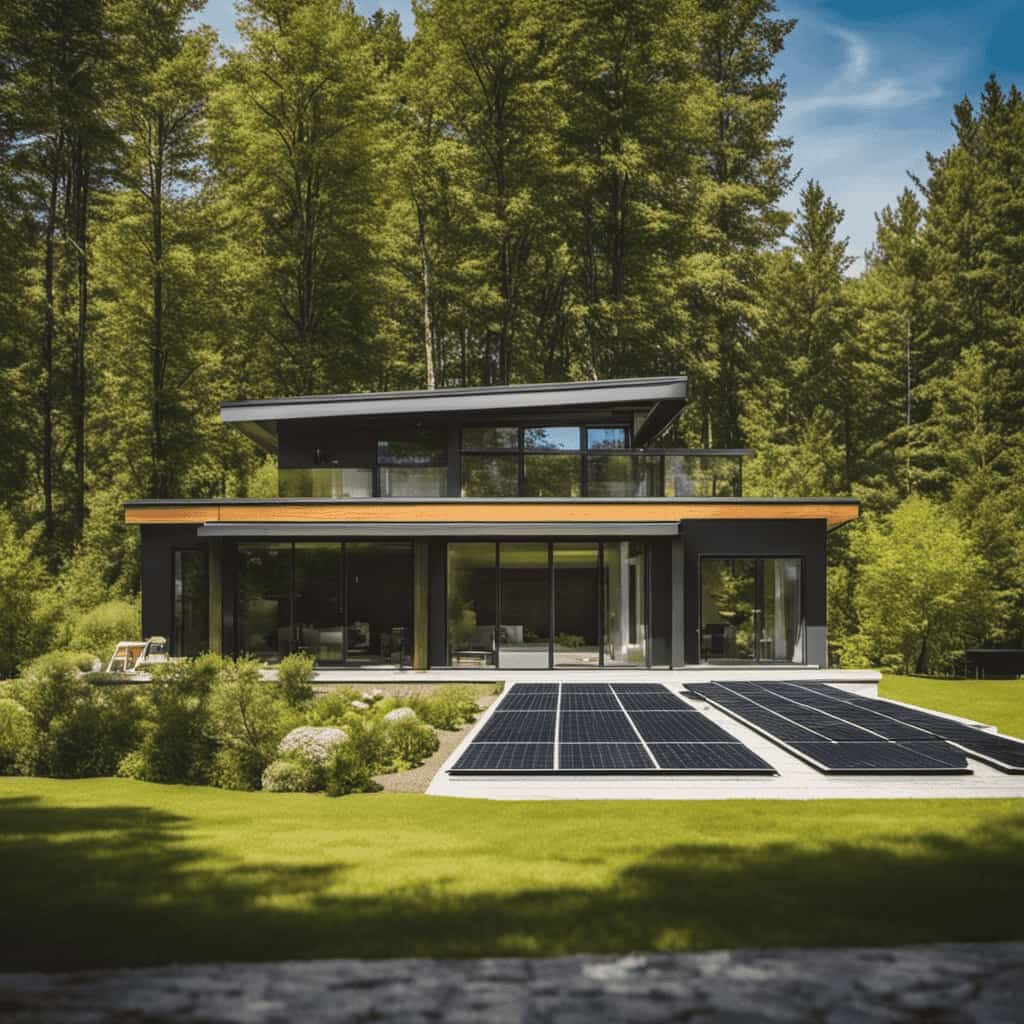We thought we knew everything about geothermal heat pumps, but this quiz has shown us some new perspectives.
Get ready to test your knowledge on the basics, efficiency, types, environmental benefits, and common misconceptions of geothermal heat pumps.
We’ll also dive into maintenance, troubleshooting, and how they stack up against traditional systems.
Plus, we’ll explore the latest innovations and advancements in this groundbreaking technology.

Get ready to challenge your understanding and discover the future of heating and cooling.
Key Takeaways
- Geothermal heat pumps use the constant temperature of the earth for heating and cooling, making them highly efficient.
- Proper installation involves determining the size and layout of the ground loop and ensuring insulation and sealing to minimize heat loss or gain.
- Geothermal heat pumps have higher upfront costs but can provide significant energy savings in the long run.
- Geothermal heat pumps reduce carbon emissions, utilize renewable energy sources, and contribute to environmental harmony.
The Basics of Geothermal Heat Pumps
Let’s start by exploring the basics of geothermal heat pumps.
Geothermal heat pump installation involves digging trenches or drilling boreholes to access the Earth’s constant temperature below the surface. These systems use a network of pipes, filled with a refrigerant, to extract heat from the ground during winter and transfer it into the building.
During summer, the process is reversed, with heat from the building being expelled into the ground.

This method of heating and cooling offers several benefits.
Geothermal heat pumps are highly efficient, using up to 50% less energy than traditional HVAC systems. They also provide consistent heating and cooling throughout the year and have a longer lifespan.
Moreover, they’re environmentally friendly, emitting fewer greenhouse gases and reducing reliance on fossil fuels.
Understanding Geothermal Heat Pump Efficiency
Geothermal heat pump efficiency can vary depending on factors such as system design, installation quality, and maintenance practices. Proper geothermal heat pump installation is crucial for optimizing performance.

A well-designed system will utilize the earth’s constant temperature to efficiently heat and cool a building. This involves determining the proper size and layout of the ground loop, as well as ensuring proper insulation and sealing to minimize heat loss or gain.
High-quality installation is essential to ensure optimal heat transfer between the ground and the heat pump, maximizing efficiency. Regular maintenance is also important to keep the system operating at peak performance. This includes regular inspections, cleaning, and checking for any potential issues that could affect efficiency.
Exploring Different Types of Geothermal Heat Pumps
Now let’s take a closer look at the pros and cons of different types of geothermal heat pumps. Understanding the advantages and disadvantages of each type will help us make informed decisions when it comes to selecting the best option for our specific needs.
Additionally, we should also consider a cost comparison between the different types of geothermal heat pumps. Comparing the costs associated with each option will allow us to evaluate the long-term financial implications of our choices.

Pros and Cons
We have identified several key pros and cons of different types of geothermal heat pumps. When considering the installation process, there are several advantages and disadvantages to consider:
Pros of the installation process:
- Energy efficiency: Geothermal heat pumps are highly efficient, using the constant temperature of the earth to provide heating and cooling.
- Long lifespan: These systems have a longer lifespan compared to traditional HVAC systems, reducing the need for frequent replacements.
Cons of the installation process:
- High upfront cost: The initial installation cost of geothermal heat pumps can be higher compared to conventional systems, making it a significant investment.
- Complex installation: Installing geothermal heat pumps requires expertise and specialized equipment, which can increase the complexity and cost of the process.
Cost Comparison
When comparing different types of geothermal heat pumps, one important aspect to consider is the cost. The cost of geothermal heat pump installation can vary depending on several factors, including the size and layout of your property, the type of heat pump system you choose, and the local labor and material costs.

However, it’s important to note that while the upfront cost of geothermal heat pumps may be higher than traditional heating and cooling systems, the long-term savings can be significant. Geothermal heat pumps are highly energy-efficient and can reduce your energy bills by up to 50%. Additionally, they have a longer lifespan than traditional systems, reducing the need for frequent replacements.
The Environmental Benefits of Geothermal Heat Pumps
Geothermal heat pumps offer significant environmental benefits, including reduced carbon emissions and energy efficiency advantages. By utilizing the constant temperature of the earth, these systems can reduce the reliance on fossil fuels for heating and cooling, thereby lowering greenhouse gas emissions.
Additionally, geothermal heat pumps are highly efficient, providing more energy output compared to the energy input required to operate them, resulting in lower energy consumption and reduced environmental impact.
Reduced Carbon Emissions
Fortunately, geothermal heat pumps significantly reduce carbon emissions. This is because they rely on renewable energy sources to provide sustainable heating.

Here are a few reasons why geothermal heat pumps are environmentally friendly:
-
Efficient Energy Use:
-
Geothermal heat pumps utilize the constant temperature of the earth to efficiently heat and cool buildings.
-
They require less energy compared to traditional heating and cooling systems, resulting in lower carbon emissions.

-
Reduced Fossil Fuel Dependency:
-
Geothermal heat pumps minimize the need for fossil fuels, such as natural gas or oil, for heating purposes.
-
By reducing reliance on fossil fuels, geothermal heat pumps help decrease carbon dioxide emissions, a major contributor to global warming.
Energy Efficiency Advantages
But did you know that geothermal heat pumps also offer energy efficiency advantages? These systems are designed to maximize energy savings and provide a long term investment for homeowners.

Geothermal heat pumps utilize the constant temperature of the earth to efficiently heat and cool homes, reducing energy consumption and lowering utility bills. By transferring heat from the ground to the home during the winter and vice versa during the summer, these pumps require less energy compared to traditional heating and cooling systems. This results in significant cost savings over time, making geothermal heat pumps a wise choice for those looking to reduce their carbon footprint and save money in the long run.
With their energy efficiency advantages, geothermal heat pumps are a sustainable and environmentally-friendly solution for heating and cooling needs.
Common Misconceptions About Geothermal Heat Pumps
We often misunderstand the efficiency of geothermal heat pumps. There are several common misconceptions about these systems that can lead to inaccurate assumptions about their energy savings potential. Let’s clear up some of these misconceptions:
-
Geothermal heat pumps aren’t efficient in cold climates:
Contrary to popular belief, geothermal heat pumps can still operate efficiently in cold climates. They extract heat from the ground, which remains relatively stable throughout the year, providing a consistent source of energy for heating even in cold weather.
-
Geothermal heat pumps aren’t cost-effective:
While the initial installation cost of a geothermal heat pump may be higher than traditional systems, the long-term energy savings can offset this expense. These systems can reduce energy consumption by up to 70%, resulting in significant cost savings over time.
Maintaining and Troubleshooting Geothermal Heat Pumps
Maintaining geothermal heat pumps requires regular inspections and scheduled maintenance to ensure optimal performance and minimize potential issues.
To troubleshoot any problems that may arise, there are a few techniques you can employ.
First, check the power supply to ensure it’s properly connected and functioning.

Next, inspect the thermostat settings and make sure they’re set correctly.
If the heat pump isn’t producing enough heat, check the air filters and clean or replace them if necessary.
Additionally, check the condensate drain for any clogs or blockages.
Regularly cleaning the heat exchanger and condenser coils will also help ensure efficient operation.

Finally, be sure to monitor the pressure and temperature levels to detect any abnormalities.
Geothermal Heat Pumps Vs. Traditional Heating and Cooling Systems
One major advantage of geothermal heat pumps over traditional heating and cooling systems is their significantly higher energy efficiency. Geothermal heat pumps use the constant temperature of the earth to heat and cool buildings, which requires much less energy compared to traditional HVAC systems that rely on burning fossil fuels.
Here is a comparison of the energy savings between geothermal heat pumps and traditional systems:
-
Geothermal Heat Pumps:

-
Can achieve energy efficiencies of up to 400-600%, meaning they can produce 4-6 units of heat for every unit of electricity consumed.
-
Can save homeowners up to 70% on their heating and cooling costs compared to traditional systems.
-
Traditional HVAC Systems:
-
Typically have energy efficiencies ranging from 80-98%, meaning they produce 0.8-0.98 units of heat for every unit of electricity consumed.

-
Generally result in higher energy bills due to the reliance on fossil fuels and less efficient technology.
Innovations and Advancements in Geothermal Heat Pump Technology
Geothermal heat pump technology has seen significant innovations and advancements in recent years. These developments have revolutionized the way we harness the Earth’s natural heat to provide heating, cooling, and hot water for residential and commercial buildings.
One major advancement is the use of advanced control systems that optimize the performance of geothermal heat pumps. These systems monitor and adjust various parameters such as temperature, flow rate, and pressure to ensure maximum efficiency and comfort.
Another innovation is the use of variable speed compressors, which allow the heat pump to adjust its heating and cooling output based on the current demand. This results in more precise temperature control and reduced energy consumption.

Additionally, advancements in drilling techniques and materials have made it easier and more cost-effective to install geothermal heat pump systems.
These innovations and advancements in geothermal heat pump technology have greatly improved the efficiency, reliability, and affordability of these systems, making them an attractive option for those seeking sustainable and energy-efficient heating and cooling solutions.
Frequently Asked Questions
How Much Does It Cost to Install a Geothermal Heat Pump System?
Geothermal heat pump installation cost varies depending on factors such as system size and site conditions. Pros include energy efficiency and long-term savings. Cons include high upfront costs. Consider these factors when evaluating the investment.
Are There Any Disadvantages or Drawbacks to Using a Geothermal Heat Pump?
There are some disadvantages and drawbacks to using geothermal heat pumps. One interesting statistic is that geothermal systems can be more expensive to install compared to traditional heating and cooling systems.

Can a Geothermal Heat Pump Be Installed in Any Type of Home or Building?
A geothermal heat pump can be installed in any type of home or building. The installation process involves drilling boreholes, laying underground pipes, and connecting the system to the heat pump. The benefits of geothermal heat pumps include energy efficiency and reduced carbon footprint.
How Long Does It Take for a Geothermal Heat Pump System to Pay for Itself in Energy Savings?
On average, a geothermal heat pump system pays for itself in energy savings within 5 to 10 years. Factors such as energy prices, installation costs, and system efficiency can affect the payback period.
Are There Any Government Incentives or Tax Credits Available for Installing a Geothermal Heat Pump System?
Yes, there are government incentives and tax credits available for installing a geothermal heat pump system. These incentives and credits can help offset the initial cost and make the system more affordable.
Conclusion
In conclusion, geothermal heat pumps offer an efficient and environmentally friendly solution for heating and cooling homes. By harnessing the Earth’s natural heat, these systems provide consistent comfort while reducing carbon emissions.

With advancements in technology, geothermal heat pumps continue to evolve and improve, making them a viable alternative to traditional heating and cooling systems.
So, if you’re looking for a sustainable and cost-effective way to regulate your home’s temperature, consider exploring the benefits of geothermal heat pumps.









